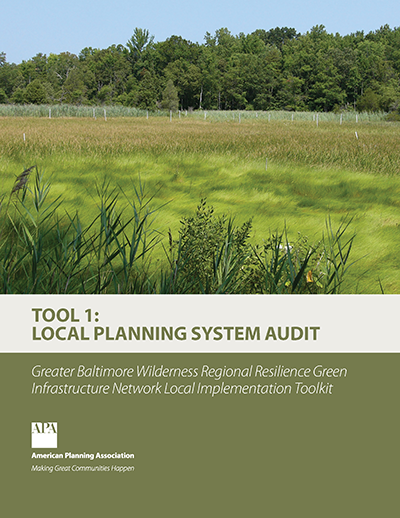Greater Baltimore Wilderness: Green Infrastructure for Regional Resilience
Project Overview
The Greater Baltimore Wilderness Coalition is a group of local, state, and national organizations working to conserve, restore, and enhance a regional green infrastructure network delivering multiple benefits for the people and wildlife of central Maryland.
The coalition's first major project was an exploration of opportunities to use green infrastructure across the Patapsco, Patuxent, and Gunpowder River watersheds to enhance resilience to coastal storms and climate change.
Thanks to support from the National Fish and Wildlife Foundation, a project team led by the Conservation Fund, with APA as co-principal investigator, developed a Green Infrastructure Identification and Ranking portal and local implementation toolkit to guide local and regional policy and actions. APA Research Director David Rouse, FAICP, co-author of PAS Report No. 571, Green Infrastructure: A Landscape Approach, led the APA team's work on the project.
In addition to researching planning best practices related to using green infrastructure to enhance local and regional resilience, APA used its Community Planning Assistance Teams (CPAT) program to help two local jurisdictions in the project study area develop green infrastructure action plans.
Greater Baltimore Wilderness Regional Resilience Green Infrastructure Network Local Implementation Toolkit
This five-part toolkit is a companion to the Greater Baltimore Wilderness Region Green Infrastructure Identification and Ranking portal.
Brooklyn/Baybrook Community Action Plan
Community Planning Assistance Team Report
Brooklyn/Baybrook Community Action Plan presents the findings and recommendations from a Community Planning Assistance Team (CPAT) project. The CPAT worked closely with the Chesapeake Center for Youth Development and many other stakeholders to develop a concept plan for transforming the currently underutilized Garrett Park into a multigenerational community hub and to propose actions that residents and stakeholders can take to increase community resilience through green infrastructure.
A Green Infrastructure Vision for Harford County, Maryland
Community Planning Assistance Team Report
A Green Infrastructure Vision for Harford County, Maryland, presents the findings, recommendations, and observations from a Community Planning Assistance Team (CPAT) project in Harford County, Maryland. The CPAT assisted the county with a community visioning workshop to help establish the parameters for delineating a green infrastructure network, as well as identify and prioritize land acquisition and restoration projects within the more rural Upper Little Gunpowder Falls and the more urban Lower Gunpowder River watersheds.
Supporting a Regional Green Infrastructure Network Through Local Policy and Action
Supporting a Regional Green Infrastructure Network Through Local Policy and Action outlines numerous potential green infrastructure tools localities can use to enhance resilience to coastal storms and climate change. It includes noteworthy examples from within the Coastal Resilience for Greater Baltimore project area and across the country to illustrate each tool.
Presentations
- On December 11, 2015, the project team held a workshop at the Patuxent Research Refuge Visitor Center in Laurel, Maryland, for local planners in the project area. At this workshop, APA staff summarized an inventory of existing plans, policies, regulations, and programs throughout the project area and presented a draft framework for supporting a regional green infrastructure network through local policy and action.
- On January 31, 2015, APA staff joined other members of the Greater Baltimore Wilderness Coalition to present a general overview of green infrastructure at multiple scales at the New Partners for Smart Growth Conference in Baltimore.






